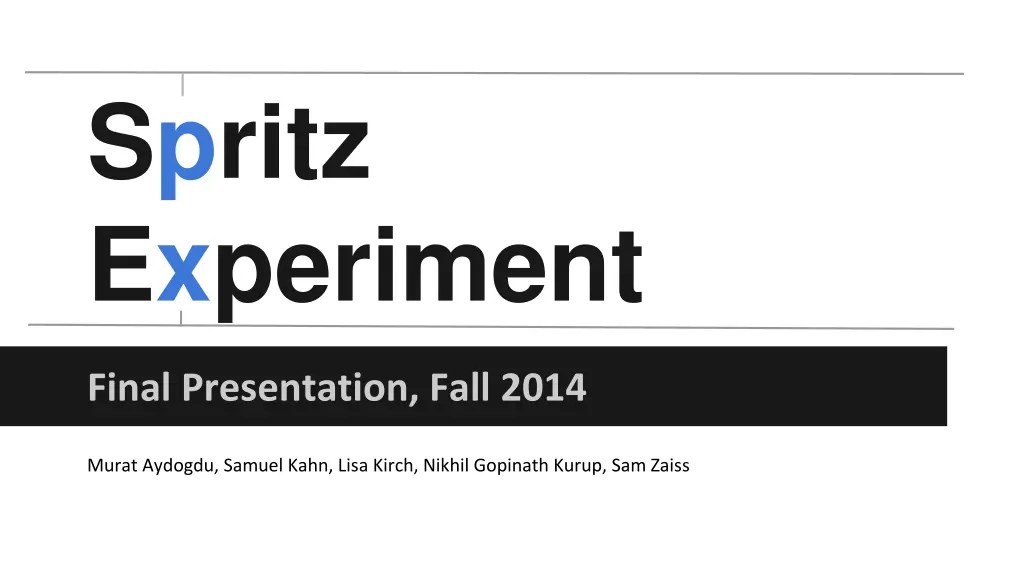
Spritz Experiment on Speed Reading with RSVP Methodology
Explore the Spritz Experiment's findings on speed reading using the RSVP method, dating back to 1925. Discover how reading speed and comprehension were influenced by the implementation of Spritz. Dive into past research outcomes and our experiment design to understand the impact on reading speed and comprehension levels.
Download Presentation

Please find below an Image/Link to download the presentation.
The content on the website is provided AS IS for your information and personal use only. It may not be sold, licensed, or shared on other websites without obtaining consent from the author. If you encounter any issues during the download, it is possible that the publisher has removed the file from their server.
You are allowed to download the files provided on this website for personal or commercial use, subject to the condition that they are used lawfully. All files are the property of their respective owners.
The content on the website is provided AS IS for your information and personal use only. It may not be sold, licensed, or shared on other websites without obtaining consent from the author.
E N D
Presentation Transcript
Spritz Experiment Final Presentation, Fall 2014 Murat Aydogdu, Samuel Kahn, Lisa Kirch, Nikhil Gopinath Kurup, Sam Zaiss
Speed Reading & RSVP Efforts to systematically improve reading speed date back to 1925, focused on text features. In the 1970s, text presentation methods emerged as a means to help increase reading speed without sacrificing comprehension. One such method -- rapid serial visual presentation (RSVP) -- was the basis for multiple speed reading apps post-2000.
Past Research: Effects of RSVP Wobbrock, Forlizzi, Hudson, & Myers (2002): Used RSVP to achieve reading speeds up to 720 wpm, but not in a controlled experiment. quist & Goldstein (2002): RSVP improved reading speeds by 33% for short texts. Didn t help reading speed for longer texts, and also increased cognitive load.
Our Focus & Hypothesis PSB (2014) experiment found positive effect for Spritz in speed & marginally negative effect for comprehension. Specifics of the PSB study are unclear; there were some drawbacks. We hypothesized that using Spritz, participants reading speed would increase while comprehension would stay constant for slightly longer texts.
Experiment Design: Participants Used Amazon Mechanical Turk to recruit 550 participants. 50 Pilot/500 Main Experiment Challenges included tuning the restrictions correctly and locking on the appropriate incentive amount to reach 500 participants quickly. AMT users tend to mostly be from the US and India, and vary as a group from the population of these countries overall.
Experiment Design: Materials We built a website to take AMT participants through the entirety of the experiment:
Experiment Design: Procedure Within-subjects design. Each subject read two articles: One normally, and one with Spritz. Subjects were randomly assigned to four conditions based on counterbalancing control / treatment order and article order. To account for any effects of seeing Spritz for the very first time, we gave subjects a brief practice before showing the article. Each article was followed by 5 comprehension questions. The experiment concluded with general demographic questions.
Results: Descriptive Statistics Our subjects (N = 487) Primary language: English (90%) Men (52%) and women (48%) White (59%), Asian (24%), and other races College degree and more Use glasses (47%), new to Spritz (83%) Read Text messages and social media Books or e-books Science and technology journals Magazine articles or blogs Professional documents like emails or reports I don't read any of the above 405 320 129 324 255 0
Results: Model & Analysis Four conditions from counterbalancing article order and treatment order. Subjects were randomly assigned to conditions: The first article is Total FUN SAD 123 119 242 FUN The Spritz article is 135 110 245 SAD Total 258 229 487 Outcome: How many of the 5 questions did the subject get right for each article?
Results: Model & Analysis The everything model Number of correct answers Spritz = 1 Normal = 0 SAD article = 1 FUN article = 0 First article is normal = 1 First article is Spritz = 0 summary(lm(Y ~ trt + isSAD + firstNormal + Age + SpritzExp + UsesGlasses + DegreeCode + PrimEng + Female + RaceCode + readTM + readBook + readSci + readMag +readProf))
Conclusion Main finding: negative treatment effect Possible explanations - gradual learning? Comparison to PSB study Spritz folks don t do too bad with comprehension (Control: 76%, Limited Speed Spritz: 68%) Statistical significance not assessed clearly Subjects not experienced with Spritz
Spritz Experiment Spritz Experiment Q&A
